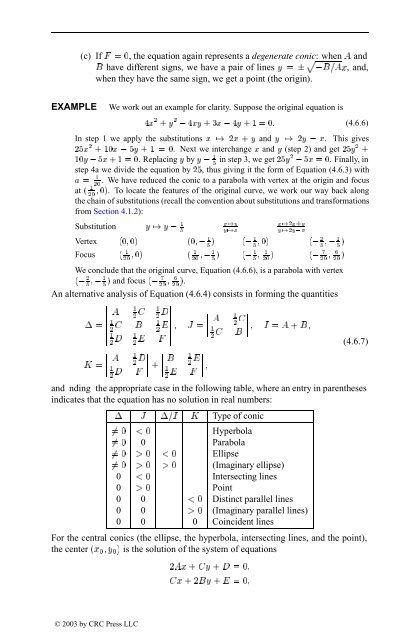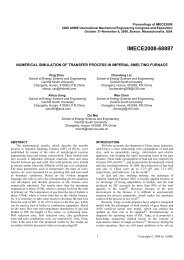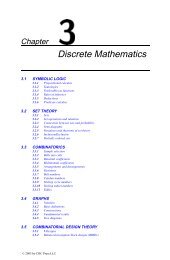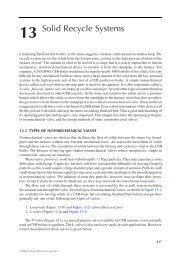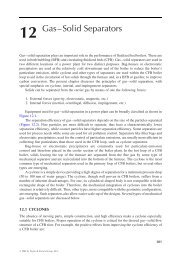Chapter 4: Geometry
Chapter 4: Geometry
Chapter 4: Geometry
Create successful ePaper yourself
Turn your PDF publications into a flip-book with our unique Google optimized e-Paper software.
(c) If ¼, the equation again represents a degenerate conic: when and<br />
have different signs, we have a pair of lines Ý ¦ Ô Ü, and,<br />
when they have the same sign, we get a point (the origin).<br />
EXAMPLE<br />
We work out an example for clarity. Suppose the original equation is<br />
Ü ¾ · Ý ¾ ÜÝ ·¿Ü Ý ·½¼ (4.6.6)<br />
In step 1 we apply the substitutions Ü ¾Ü · Ý and Ý ¾Ý Ü. This gives<br />
¾Ü ¾ ·½¼Ü Ý ·½ ¼. Next we interchange Ü and Ý (step 2) and get ¾Ý ¾ ·<br />
½<br />
½¼Ý Ü ·½¼. Replacing Ý by Ý in step 3, we get ¾Ý¾ Ü ¼. Finally, in<br />
<br />
step 4a we divide the equation by ¾, thus giving it the form of Equation (4.6.3) with<br />
<br />
½ . We have reduced the conic to a parabola with vertex at the origin and focus<br />
¾¼<br />
at ´ ½ ¼µ. To locate the features of the original curve, we work our way back along<br />
¾¼<br />
the chain of substitutions (recall the convention about substitutions and transformations<br />
from Section 4.1.2):<br />
½<br />
ÜÝ<br />
ܾܷÝ<br />
Substitution Ý Ý<br />
<br />
ÝÜ<br />
Ý¾Ý Ü<br />
½<br />
Vertex ´¼ ¼µ ´¼<br />
µ ´ ½<br />
¼µ<br />
´ ¾<br />
½<br />
µ<br />
Focus ´ ½ ¾¼ ¼µ<br />
´ ½ ½<br />
¾¼ µ ´ ½<br />
½<br />
¾¼ µ ´ <br />
<br />
¾¼ ¾¼ µ<br />
We conclude that the original curve, Equation (4.6.6), is a parabola with vertex<br />
¾<br />
´ ½<br />
<br />
µ and focus ´ µ.<br />
¾¼ ¾¼<br />
An alternative analysis of Equation (4.6.4) consists in forming the quantities<br />
¡<br />
à <br />
¬<br />
½<br />
<br />
½ ¾ ¾<br />
¬¬¬¬¬¬ <br />
¬<br />
½<br />
¾ ¬<br />
½<br />
 <br />
¾ ¬ ½<br />
¾ ¬¬¬<br />
½<br />
½<br />
½ Á · <br />
¾<br />
¾ ¾ ¬ ¬ ½<br />
¾ ¬¬¬ ¬<br />
½<br />
·<br />
¬ ½<br />
¾ ¬¬¬<br />
½<br />
<br />
¾ ¾<br />
(4.6.7)<br />
and nding the appropriate case in the following table, where an entry in parentheses<br />
indicates that the equation has no solution in real numbers:<br />
¡ Â ¡Á Ã Type of conic<br />
¼ ¼ Hyperbola<br />
¼ 0 Parabola<br />
¼ ¼ ¼ Ellipse<br />
¼ ¼ ¼ (Imaginary ellipse)<br />
0 ¼ Intersecting lines<br />
0 ¼ Point<br />
0 0 ¼ Distinct parallel lines<br />
0 0 ¼ (Imaginary parallel lines)<br />
0 0 0 Coincident lines<br />
For the central conics (the ellipse, the hyperbola, intersecting lines, and the point),<br />
the center ´Ü ¼ Ý ¼ µ is the solution of the system of equations<br />
¾Ü · Ý · ¼<br />
Ü ·¾Ý · ¼<br />
© 2003 by CRC Press LLC


